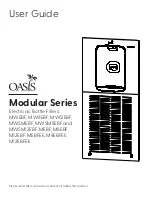
www
.
sandpiperpump
.
com
Model ST1½/ST40 •
6
st15dl4sm-rev0316
Recommended Installation Guide
Filling the Driver Chambers with Liquid
THE DRIVER CHAMBERS WILL BE
FILLED WITH DISTILLED WATER AT THE
FACTORY. IF THE INNER CHAMBER IS
CAST IRON, THE UNIT IS FILLED WITH
ETHYLENE GLYCOL.
If you prefer to substitute another liquid, to prevent
system contamination consult the factory first to
determine compatibility of the substitute with pump
construction.
Follow the steps listed below to replace the liquid
in the pump after disassembly or liquid loss:
Step 1
. Disconnect air supply from pump before
starting any work. Remove the fill and drain
plugs (¼ NPT) (.0635 cm) from the driver chambers.
After the chambers are completely drained of all
liquid, replace the drain plugs and tighten them
securely.
NOTE:
Use thread sealant on plug threads.
Step 2
. Remove the two large (1 NPT) (2.54
cm) pipe plugs (one on each side) located in
the rear of the innermost air chambers.
Step 3
. Determine which side of the pump is on the
discharge stroke and which side is on the suction
stroke by checking the positions of the diaphragm
assemblies. The cast inner diaphragm plate closest
to the pump intermediate housing, or centerline,
is the chamber in the suction stroke position. The
opposite chamber, with cast inner diaphragm plate
away from unit centerline, is in the discharge stroke
position.
NOTE:
The diaphragm assemblies (cast
inner diaphragm plates) are visible through the two
tapped holes in the inner chambers from which the
two large pipe plugs were removed.
Step 4
.
For pumps with air valve assemblies
031.098.010 or 031.098.156
Insert the safety clip (210-008-330) on one side
of the main air valve body and cycle the pump at 5
to 10 psi. As you face the pump, the side with the pin
should be the first driver fluid reservoir to be filled.
The driver diaphragm will be on a suction
stroke. Pour the correct amount of liquid into the
reservoir. The fluid level will not come completely to
the top. Loosely install the pipe plug, with pipe dope,
PTFE tape or o-ring (depending on pump model)
placed on the threads. Release all air pressure to the
pump and remove the safety clip. The diaphragm will
relax and will come to center. Watch the loose pipe
plug closely as air escapes and the driver fluid level
rises. Insert the safety clip on the opposite side and
add a small amount of air pressure. When you see
liquid weeping out between the loose pipe plug and
fill hole, tighten the pipe plug. Repeat the procedure
for the unfilled chamber.
If you have a problem getting the driver fluid to come
to the top, a blunt instrument can be inserted into the
chamber port of the pump and pressure can manually
be applied to the pumping diaphragm to cause the
liquid to come to the top. Do this carefully. A needle
valve for precision stroking control is recommended
at the air inlet for this procedure. Please be aware that
air left in the chambers will result in faulty operation of
the pump and will cause premature pumping
diaphragm failure.
For pumps not equipped with Visual Leak Detection
sight tubes, fill with 1200ml/ 40.6 fl. oz.
For pumps equipped with Visual Leak Detection sight
tubes, fill with 1250ml/ 42.3 fl. oz.
Use pipe sealant on pipe plugs. Cast iron fluid
chambers typically filled with normal antifreeze.
Step 5
. After filling, the liquid will not come all the
way to the top of the filling hole. Use a screwdriver or
similar tool to apply leverage on the inner diaphragm
plate (diaphragm assembly) forcing the driver
diaphragm on the side you have just filled partially
through its discharge stroke until the liquid level in the
chamber you are filling comes to the top of the fill hole.
This displaces any air in the chamber.
CAUTION:
Do
not pry on or damage the elastomer diaphragm while
performing this step of the filling instructions.
Step 6
. Re-plug the fill hole and tighten securely.
NOTE:
Use thread sealant on plug threads and tighten
only until snug.
Step 7
. Using a screwdriver or similar tool apply
leverage on the inner diaphragm plate (diaphragm
assembly), on the side just filled, forcing the pump to
“shift” or reverse diaphragm positions.
Step 8.
Follow steps (4) thru (6) to fill the opposite
driver chamber.
Step 9
. Re-install the two large pipe plugs in the rear
of the pump inner air chambers.
NOTE:
Use thread
sealant on plug threads.
2: INST
AL
& OP



































